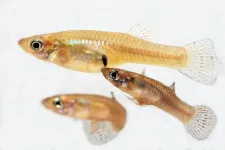CNIO researchers help to decipher the structure of the large molecular machine that activates mTOR
"As our understanding of the mechanisms that control mTOR grows, new possibilities are opening up to interfere with these processes for therapeutic purposes," says Óscar Llorca, co-author of the study
2021-07-07
(Press-News.org) The principle that form follows function does not only apply to design and architecture. It also applies to biology. Every organism is a universe that lives thanks to the activities of tens of thousands of nanomachines, whose functions depend on their forms. Biologists say macromolecular complexes instead of nanomachines and structure instead of form, but the idea is the same: know the form and you will understand the function. Now, a group at the Spanish National Cancer Research Centre (CNIO) has helped determine the structure of a nanomachine essential for the functioning of another, mTOR, which plays fundamental roles in cancer and nutrition, ageing and other vital processes in the body.
The study, published in the journal Cell Reports, was carried out by the groups of Laurence H. Pearl and Chrisostomos Prodromou from the Genome Damage and Stability Centre at the University of Sussex (UK), in collaboration with Óscar Llorca, Director of the Structural Biology programme and Head of the Macromolecular Complexes in DNA Damage Response Group at the CNIO.
The golden age of structures
The finding comes in the middle of the golden age of structural biology. Researchers speak of the structural revolution: in recent years, the shape of an increasing number of molecular nanomachines has been solved, at a much faster rate than was typical a decade ago. The change is due to high-resolution cryo-electron microscopy, a technique that has made spectacular progress and now allows proteins to be visualised in atomic detail.
Knowing the structure of proteins helps in the search for new drugs. Proteins interact by fitting together, as in a tiny three-dimensional jigsaw puzzle; knowing the shape of one piece allows us to try to design another one that matches it and blocks it, thereby inhibiting it.
The importance of understanding how mTOR works
The mTOR protein acts as a sensor that alerts the cell to the presence of nutrients. Since its discovery in the 1990s, it has been observed to be involved in a wide range of pathologies, including cancer, diabetes and neurodegenerative diseases. It is estimated that at least 60% of tumours show some form of modification in mTOR or proteins that interact with it.
It is, therefore, crucial to understand in detail how it works. But mTOR is not a protein that works alone: it is part of a macromolecular complex, a cluster of several proteins that join to work together like the parts of a complex (nano-) machine. As Llorca explains, "mTOR alone does nothing; it is part of a giant structure that contains other proteins, which allows it to behave in a complex way."
An assembly line of proteins
As with many other large macromolecular structures, the construction of the mTOR complex needs the help of other nanomachines that, "like an assembly line, add and assemble the elements of the final large structure," explains Llorca. If this large structure is not assembled, "mTOR is not able to decide whether the cells should grow or not."
The functioning of the proteins that make up this mTOR assembly army is not yet well understood.
The study carried out by Mohinder Pal, a researcher of the Pearl and Prodromou groups at the University of Sussex (UK) in collaboration with Llorca, helps to shed further light on this by determining the structure of part of the assembly machinery and the mechanisms by which it can recognise and manipulate mTOR.
The significance of the result is not merely fundamental. As Llorca points out, "as our understanding of the mechanisms that control mTOR grows, new possibilities are opening up to interfere with these processes for therapeutic purposes."
INFORMATION:
This work was supported by the Spanish Ministry of Science and Innovation, the National Institute of Health Carlos III, the Welcome Trust, the European Regional Development Fund, the Biotechnology and Biological Sciences Research Council (BBSRC) and the Community of Madrid.
Reference Article: Structure of the TELO2-TTI1-TTI2 complex and its function in TOR recruitment to the R2TP chaperone. Pal et al. (Cell Reports, 2021). DOI: 10.1016/j.celrep.2021.109317
ELSE PRESS RELEASES FROM THIS DATE:
2021-07-07
A team led by researchers from Queen Mary University of London has developed a new artificial intelligence (AI) tool that is able to automatically measure the amount of fat around the heart from MRI scan images.
Using the new tool, the team was able to show that a larger amount of fat around the heart is associated with significantly greater odds of diabetes, independent of a person's age, sex, and body mass index.
The research is published in the journal Frontiers in Cardiovascular Medicine and is the result of funding from the CAP-AI programme, which is led by Barts Life Sciences, a research and innovation partnership between Queen Mary University of London and Barts Health NHS Trust.
The distribution of fat in the body can influence a person's ...
2021-07-07
Many people instinctively associate mucus with something disgusting, but in fact, it has incredibly many valuable functions for our health. It keeps track of our important intestinal flora and feeds the bacteria. It covers all internal surfaces of our body, and, as a barrier to the outside world, it helps us protect ourselves from infectious diseases.
This is because mucus acts as a filter that keeps the bacteria in or out, and the bacteria feed on the sugars in the mucus between meals. So, if we can produce the mucus that is already present in the body with the right sugars, it might be used in brand new medical treatments.
Now, researchers from the DNRF Centre ...
2021-07-07
Physicists of Ruhr-Universität Bochum (RUB) have taken spectacular pictures that allow the ignition process of plasma under water to be viewed and tracked in real time. Dr. Katharina Grosse has provided the first data sets with ultra-high temporal resolution, supporting a new hypothesis on the ignition of these plasmas: In the nanosecond range, there is not enough time to form a gas environment. Electrons generated by field effects lead to the propagation of the plasma. The nanosecond plasma ignites directly in the liquid, regardless of the polarity of the voltage. The report from the Collaborative Research Centre 1316 "Transient Atmospheric Pressure Plasmas: from Plasma to Liquids to Solids" has been published in the Journal of Applied Physics and Rubin, the ...
2021-07-07
COLUMBUS, Ohio - Female vampire bats establish an egalitarian community within a roost rather than a society based on a clear hierarchy of dominance that is often seen in animal groups, a new study suggests.
Researchers observed more than 1,000 competitions for food among a colony of 33 adult female bats and juveniles living in captivity, assigning a rank to each bat based on a calculation of wins and losses in those contests.
The team found that, unlike in many mammal societies, the higher-ranking animal didn't necessarily win every bout over food, and there was a randomness to the ranking order - no specific quality they measured gave a bat a better chance at dominance, so any adult female had an equal opportunity to rank very high or very low on a scale of ...
2021-07-07
Environmental education provision needs greater investment and innovation if future generations are to be able to respond fully to the climate emergency, experts have said.
The deepening environmental crisis will continue to worsen if there is not significant support and investment in environmental and science education, researchers have warned. Reforms would help young people to address the complex, interlinked and dynamic issues of our contemporary situation.
The experts argue Governments and other organisations must direct more funding to education innovation in response to consistent warnings from scientists about trends in the deteriorating state of ecosystems, biodiversity and climate, amongst other environmental issues.
Writing in Environmental Education ...
2021-07-07
In mosquitofish, of the genus Gambusia, male fish are smaller than females - sometimes only half the size. Biologists had previously assumed that smaller male mosquitofish had at least some reproductive advantages. Researchers from the transregional collaborative research centre NC³ at Bielefeld University have shown in a systematic review and meta-analysis that larger mosquitofish are actually more successful at reproduction: they can, for instance, better challenge their rivals; they produce more sperm; and they are preferred by female fish. The re-searchers are presenting their findings today (07.07.2021) in the Journal of Animal Ecology.
Mosquitofish are small fish with nondescript coloring of the genus Gambusia, which contains some 45 species. ...
2021-07-07
There are some large shield volcanoes in the world's oceans where the lava is usually not ejected from the crater in violent explosions, but flows slowly out of the ground from long fissures. In the recent eruption of the Sierra Negra volcano in the Galapagos Islands, which lie just under a thousand kilometres off South America in the Pacific Ocean, one of these fissures was fed through a curved pathway in June 2018. This 15 kilometre-long pathway, including the kink, was created by the interaction of three different forces in the subsurface, Timothy Davis and Eleonora Rivalta from the GFZ German ...
2021-07-07
Driving through a tunnel is a challenging and risky task. Drivers need to lower their speed and adapt to poor light, while the enclosed space may make them anxious. Preventing accidents is a public health challenge that uses insights from engineering, psychology, physiology, and neuroscience. Here, in a virtual reality (VR) study in Frontiers in Psychology, scientists from China, Canada, and the USA show that playback of slow music inside tunnels can reduce tension and fatigue in drivers, making them less prone to speeding and overtaking. These results imply that well-chosen background music can help improve road safety.
"When drivers go through a tunnel, they need to process a large amount ...
2021-07-07
How do predators know to avoid brightly-coloured toxic prey? A collaboration of researchers has put social information theory to the test in a reliable real-world system to find the answer - by copying what others do, or do not, eat.
An international team of researchers from Finland, New Zealand, Colombia and the U.K. have provided the first evidence that wild birds can learn to avoid distasteful prey by observing what others eat.
"We've known for a long time that predators, like birds, associate brightly coloured warning signals with the danger of eating certain prey types. However, ...
2021-07-07
Imagine a dust particle in a storm cloud, and you can get an idea of a neutron's insignificance compared to the magnitude of the molecule it inhabits.
But just as a dust mote might affect a cloud's track, a neutron can influence the energy of its molecule despite being less than one-millionth its size. And now physicists at MIT and elsewhere have successfully measured a neutron's tiny effect in a radioactive molecule.
The team has developed a new technique to produce and study short-lived radioactive molecules with neutron numbers they can precisely control. They hand-picked several isotopes of the same molecule, each with one more neutron than the next. When they measured each molecule's energy, they were able to detect small, nearly imperceptible changes of the nuclear ...
LAST 30 PRESS RELEASES:
[Press-News.org] CNIO researchers help to decipher the structure of the large molecular machine that activates mTOR
"As our understanding of the mechanisms that control mTOR grows, new possibilities are opening up to interfere with these processes for therapeutic purposes," says Óscar Llorca, co-author of the study

